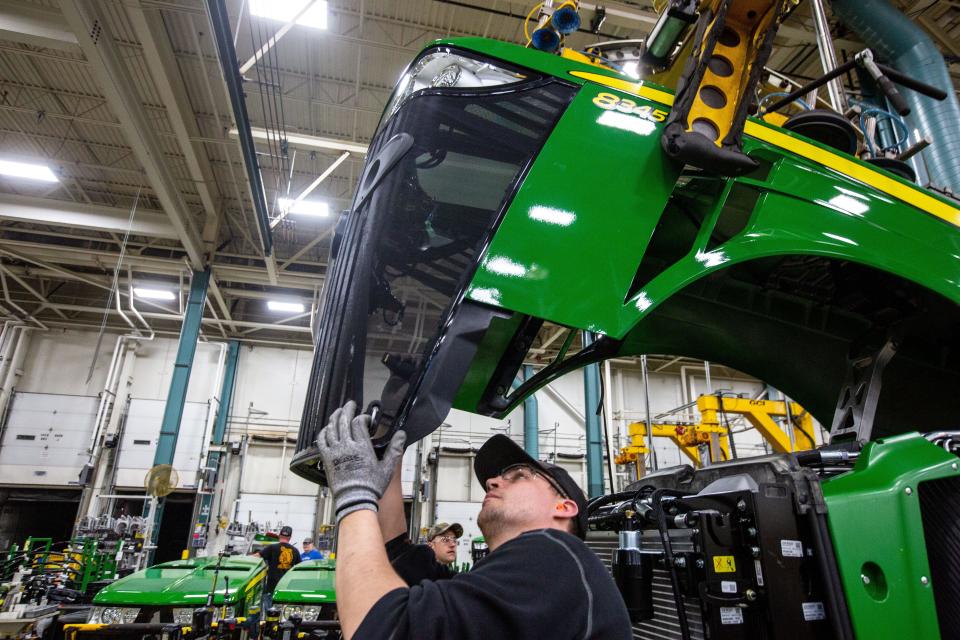Strong sales of tractors, combines and other large equipment help boost Deere profits 13%
Robust sales of tractors, combines and other precision agriculture equipment helped boost Deere & Co.'s earnings 13% in the third quarter, the Moline, Illinois, manufacturer reported Friday.
Deere said profits climbed to nearly $1.9 billion on sales that grew 25% to $13 billion in the third quarter, despite continued supply-chain disruptions. The quarter ended July 31.
“We're proud of the extraordinary efforts by our employees to increase factory output and get products to customers under challenging circumstances,” Deere CEO John May said in a statement Friday.
In a call with analysts Friday, Deere executives said the company is working through a backlog of equipment that workers were unable to finish assembling because they lacked parts or materials.
The company had about $1 billion in equipment, mostly farm machinery, in the second quarter that was awaiting parts. Deere workers finished work on about a third of those machines in the third quarter.
"We're making progress completing that inventory and getting it delivered to our dealers and customers," Cory Reed, president of Deere's agriculture and turf operations, said in the call. "We've also been able to increase our parts inventory, which is helping us as we go into the fall, to support our customers and their operations."
Deere — with Iowa plants in Ankeny, Waterloo, Davenport, Dubuque, Ottumwa, Paton and Clarion employing about 6,600 people — reported precision agriculture equipment sales grew 43% to nearly $6.1 billion in the third quarter, due to high demand and higher prices.
Small farm and lawn equipment sales climbed 16% to $3.6 billion in the third quarter. And construction and forestry equipment sales pushed 8% higher to $3.3 billion, Deere said.
Orders for the company's tractors, combines, sprayers and other farm equipment are strong through the first half of next year. Farmers can expect prices will be higher in 2023, potentially "mid-to-high single digits," Reed said.
Rob Wertheimer, director of research at Melius Research in New York, said in an earnings note he expects the list prices to increase 10%.
"Despite all the noise on production input costs for farmers, Deere’s view on demand is strongly positive (and our own view is the same)," Wertheimer said. "Higher revenues outweigh higher costs for farmers."
Iowa farmers and agriculture leaders told U.S. Agriculture Secretary Tom Vilsack in a visit to the state Thursday that their costs to put in a crop this year were 325% higher than 2021. They urged the former Iowa governor to push the Biden administration for lower U.S. tariffs on fertilizer imports.
But Matt Arnold, an analyst with Edward Jones in St. Louis, Missouri, said higher profits this year and next will help farmers replace equipment they delayed buying as farm income dragged between 2015 and 2020.
Even with supply-chain disruptions, Deere executives said the company expects to ramp up production to meet the increased demand. The company said large farm equipment sales are expected to be 25% to 30% higher for the year.
"We expect to finish the year with higher shipments and market share gains," said Rachel Bach, Deere's investor communications manager.
Deere said its small farm and turf equipment sales are expected to be up 10% to 15% and construction and forestry, up 10%.
While residential construction is expected to slow this year, spending under the $1 trillion infrastructure law is expected to begin on roads, bridges and other major projects, Bach said.
For the full year, Deere expects earnings to be between $7 billion and $7.2 billion. Though that's down slightly from last quarter, when the company forecast it would earn as much as $7.4 billion, “Looking ahead, we believe favorable conditions will continue into 2023 based on the strong response we have experienced to early order programs,” May said. “We are working closely with our factories and suppliers to meet higher levels of customer demand next year."

MORE: As John Deere shift some jobs from Iowa to Mexico, U.S. trade rep defends trade treaty
Reed and other executives said the company has incurred added costs to get the supplies they need so they can ship customers their equipment.
For example, Reed said the company spent about $25 million annually from 2018 to 2020 getting supplies flown to plants in Waterloo and Moline. This year, the company expects to spend $200 million on premium air freight costs at those plants, an "extraordinary cost" that the company decided to foot to meet customer demand, he said.
Arnold said many manufacturers are paying premium freight prices not only to get semiconductor chips and other supplies to their factories, but to ship their goods to customers.
"If you're going to face inflation pressures and supply chain challenges, it's not a terrible time to do it, with strong demand to help on the other side," he said.
Earnings for the company's first three quarters climbed 4% to nearly $4.9 billion, compared to the same time a year earlier, with sales that grew 14% to $33 billion.
Deere earned a record $5.96 billion in its most recent fiscal year, which ended last October.
Donnelle Eller covers agriculture, the environment and energy for the Register. Reach her at deller@registermedia.com or 515-284-8457.
This article originally appeared on Des Moines Register: Sales of tractors, combines boost Deere earnings 13% in 3rd quarter

